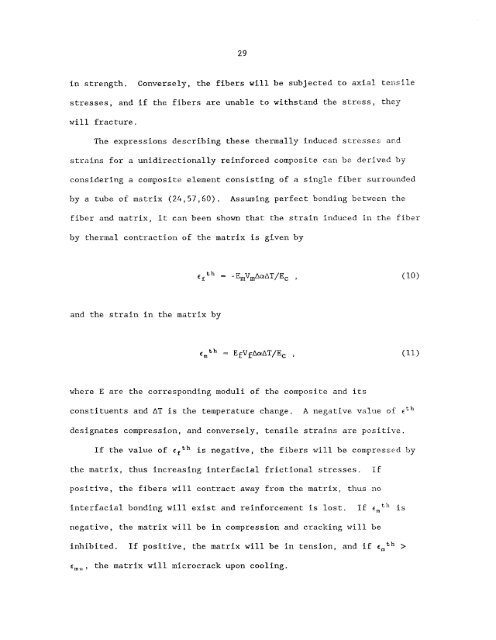Characterization and control of the fiber-matrix interface in ceramic ...
Characterization and control of the fiber-matrix interface in ceramic ...
Characterization and control of the fiber-matrix interface in ceramic ...
Create successful ePaper yourself
Turn your PDF publications into a flip-book with our unique Google optimized e-Paper software.
29<br />
<strong>in</strong> strength. Conversely, <strong>the</strong> <strong>fiber</strong>s will be subjected to axial tensile<br />
stresses, <strong>and</strong> if <strong>the</strong> <strong>fiber</strong>s are unable to withst<strong>and</strong> <strong>the</strong> stress, <strong>the</strong>y<br />
will fracture.<br />
The expressions describ<strong>in</strong>g <strong>the</strong>se <strong>the</strong>rmally <strong>in</strong>duced stresses ard<br />
stra<strong>in</strong>s for a unidirectionally re<strong>in</strong>forced composite can be? derived by<br />
consider<strong>in</strong>g a composite element consist<strong>in</strong>g <strong>of</strong> a s<strong>in</strong>gle <strong>fiber</strong> surrounded<br />
by a tube <strong>of</strong> <strong>matrix</strong> (24,57,60) ~<br />
Asswn<strong>in</strong>g perfect bond<strong>in</strong>g between <strong>the</strong><br />
<strong>fiber</strong> <strong>and</strong> <strong>matrix</strong>, it can been shown that <strong>the</strong> stra<strong>in</strong> <strong>in</strong>duced II;<br />
<strong>the</strong> <strong>fiber</strong><br />
by <strong>the</strong>rmal contraction <strong>of</strong> <strong>the</strong> <strong>matrix</strong> is given by<br />
<strong>and</strong> <strong>the</strong> stra<strong>in</strong> <strong>in</strong> <strong>the</strong> <strong>matrix</strong> by<br />
cmth = EfVfAaAT/Ec<br />
where E are <strong>the</strong> correspond<strong>in</strong>g moduli <strong>of</strong> <strong>the</strong> composite <strong>and</strong> its<br />
constituents <strong>and</strong> AT is <strong>the</strong> temperature change.<br />
A negative value <strong>of</strong> eLh<br />
designates compression, <strong>and</strong> conversely, tensile stra<strong>in</strong>s are pusitive.<br />
If <strong>the</strong> value <strong>of</strong> cfth is negative, <strong>the</strong> <strong>fiber</strong>s will be compressed by<br />
<strong>the</strong> <strong>matrix</strong>, thus <strong>in</strong>creas<strong>in</strong>g <strong>in</strong>terfacial frictional stresses. If<br />
positive, <strong>the</strong> <strong>fiber</strong>s will contract away from <strong>the</strong> <strong>matrix</strong>, thus 110<br />
<strong>in</strong>terfacial bond<strong>in</strong>g will exist <strong>and</strong> re<strong>in</strong>forcement is lost.<br />
If ernth is<br />
negative, <strong>the</strong> <strong>matrix</strong> will be <strong>in</strong> compression <strong>and</strong> crack<strong>in</strong>g will be<br />
<strong>in</strong>hibited. If positive, <strong>the</strong> <strong>matrix</strong> will be <strong>in</strong> tension, arid if ernth ><br />
emu, <strong>the</strong> <strong>matrix</strong> will microcrack upon cool<strong>in</strong>g.

















